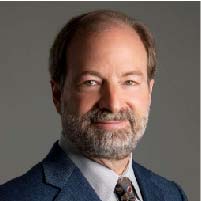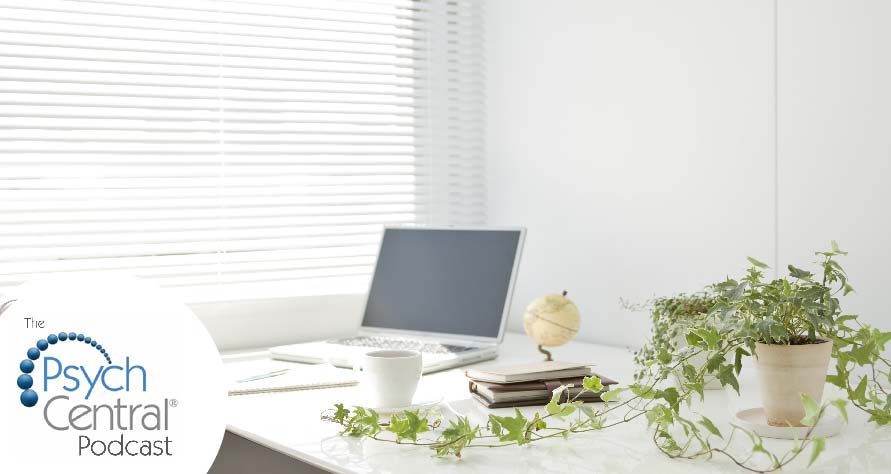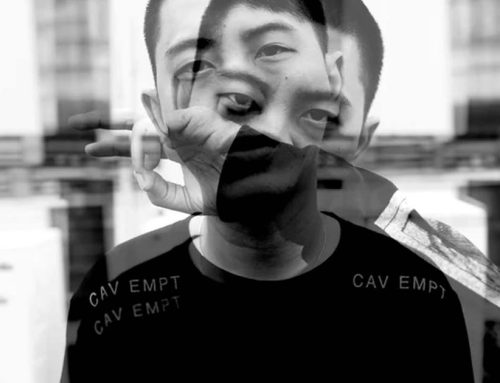Have you suddenly found yourself working from home during the COVID-19 quarantine? How can you make the most of this situation? On today’s podcast, Gabe interviews Donald M. Rattner, architect and author of My Creative Space: How to Design Your Home to Stimulate Ideas and Spark Innovation, 48 Science-based Techniques. Donald offers simple tips on setting up a mental-health friendly workspace that maximizes creativity and productivity. Click on the player below to listen now!
SUBSCRIBE & REVIEW
Guest information for ‘Home Office- Psychology’ Podcast Episode

Architect Donald M. Rattner helps individuals and organizations maximize creative performance by drawing on scientific research in design psychology. His most recent book is My Creative Space: How to Design Your Home to Stimulate Ideas and Spark Innovation, 48 Science-based Techniques, which received a 2019 Gold Award from the Nonfiction Authors Association. Educator and practitioner as well as author, Rattner has taught at the University of Illinois, New York Academy of Art, NYU, and Parsons. Speaking venues include the Creative Problem Solving Institute, Creative Mornings, and numerous conferences. His work has been featured on CNN and in such publications as The New York Times and Better Humans. Rattner received a Bachelor’s in art history from Columbia and a Masters of Architecture from Princeton.
Computer Generated Transcript for ‘Home Office- Psychology’ Episode
Editor’s Note: Please be mindful that this transcript has been computer generated and therefore may contain inaccuracies and grammar errors. Thank you.
Announcer: You’re listening to the Psych Central Podcast, where guest experts in the field of psychology and mental health share thought-provoking information using plain, everyday language. Here’s your host, Gabe Howard.
Gabe Howard: Hello, everyone, and welcome to this week’s episode of the Psych Central Podcast. Calling into the show today, we have architect Donald M. Rattner, who helps individuals and organizations maximize creative performance by drawing on scientific research in design psychology. His most recent book is My Creative Space: How to Design Your Home to Stimulate Ideas and Spark Innovation, 48 Science-based Techniques. And he holds a Bachelor’s in art history from Columbia and a Masters of Architecture from Princeton. Donald, welcome to the show.
Donald M. Rattner: Hi, Gabe. Thank you for having me.
Gabe Howard: I am excited to have you here. You know, listen, I honestly never thought that we would be in a place where we needed the marriage of psychology and architecture quite the way that we do now. The coronavirus and the related quarantines all over the country, have so many people working from home. But they’re not just working from home. They’re stuck at home. They’re stuck at home with their families. It’s just really highlighted the importance of your work.
Donald M. Rattner: Well, thank you, Dave, for saying that, because in a kind of a good, bad way, home has clearly moved front and center to the national conversation. It has taken on an even greater importance than it has traditionally had. But I think it really highlights a key factor about home, which is it is our literal and figurative place of refuge, it’s a safe space that we have uniquely in the world. It’s a kind of bulwark between us and what goes on outside the walls. And I think we’re seeing played out how important that is to us, not only physically, but mentally as well.
Gabe Howard: This is a little bit fascinating to me because I grew up with a dad who would say things like, you know, your home is your castle, you are the king of your castle. This is what you need to protect. And I always kind of rolled my eyes at my dad because I thought, I love you very much, but I think you’re being dramatic. But here we are. This is our place of refuge. But I do believe that the vast majority of people who are quarantined at home, they feel stuck. And that makes me wonder, what’s the psychological explanation for why people are struggling with being home so much? Because it does seem counterintuitive. Shouldn’t we all be thrilled to be in a space that is entirely and completely under our own control?
Donald M. Rattner: Well, let me say, first of all, that your dad was, as dads often are, totally correct. When he’s using terms and I know we’ve heard it so many times, home is our castle, etc., etc. It starts to feel, you know, like a cliche and it’s kind of lost all its meaning, except it really hasn’t. And one of the reasons that home is a kind of unique space is that it is the one place in the world where we have near total if not total control. And that sense of having control is hugely beneficial to our mental well-being. When we feel we’re in control of something, we tend to be much happier, we tend to be much healthier. We tend to be more creative because we feel like we have autonomy, we have freedom, we have the ability to do things that we might not otherwise be able to do, such as when we leave home and go to the office and there’s someone telling us what to do and when to do it and so on and so forth. So this is element of control really is critical, as is the other aspect of home, which is it is highly personalized because we have this degree of control. We can make it uniquely about us, what we feel the world should look like. Our vision of how we want to live and that sense of personalization can again make all the difference in terms of your health, your happiness, your creativity. And that’s why when you go to an office outside the home, you see people with family photos, little tchotchkes on the desk, a souvenir or two. They’re personalizing their space in a way that benefits them psychologically. But obviously, too much of a good thing is not a good thing. We do need to leave home. We do need to socialize with other people. That’s part of maintaining a healthy, creative mindset. And when we are sequestered and in a sense, our control is taken away from us because we’re not really supposed to leave home. That’s where things start to decline.
Gabe Howard: I think that part of the problem we didn’t set up our houses to be bunkers. We didn’t set them up to be in 24/7. We set them up for the evenings, for the weekends, for dinners. We didn’t set them up to be there as much as we are there now. Do you think that’s part of it? I mean, perhaps if we would have known a year ago that we were gonna be stuck inside for six weeks, we would have made different design choices.
Donald M. Rattner: Yeah, for sure. I mean, homes, as you say, are constructed, organized, planned and fitted out in such a way as to allow you to live a normal life, which is not to be in it 24/7. So clearly we have to take certain steps to adjust to the new realities. And that may mean different ways of utilizing space, different ways of segregating space as we’re all on top of each other now. But still, you know, it is very important that you do need to kind of exit that enclosure. Even if you just step outside your walls and stand in your front patio or your front yard or backyard. Because for one thing, you want to kind of reset your circadian clock, which is tied to daylight. Right? And if you’re indoors all the time, you’re only getting diffused light, whereas stepping outside amplifies how much light is coming into your brain at any given moment. All sorts of things are really demanding that we literally step outside, however limited that can be. But there’s lots of things people can do to kind of cope with the new realities.
Donald M. Rattner: One of which may come into play if you are, say, a creative professional or work in a certain industry where you need to do creative problem solving, you know, with everybody home all at once during the day, the space becomes a premium. So maybe you don’t have a dedicated home office set up. But what is important is you dedicate or you identify somewhere in the home that you’re going to do your work in. You’re going to do your creative work. And especially and even if it’s a simple technique like modifying that space with some object, if you work at the dining table, maybe you have a special place mat which you pull out only when you’re in work mode and you put your laptop down on that. And when you’re done, that mat goes away. So you start to create these kind of mental associations with space, with the objects in space, in a certain activity, certain mindset. And when it goes away, you kind of revert back to normal home life. So there are things people could do to deal with this.
Gabe Howard: I sort of want to put a little disclaimer up that says that all of your research was done before the whole world shut down. So what is the number one thing that people can do now? How can people improve their environment? Given the new constraints that come during the pandemic?
Donald M. Rattner: Well, one of the interesting things that I discovered in researching the book was the degree to which any kind of environmental cue or behavior within our environment that promotes creativity, which was the focus of my book, also tends to promote health, both physical and mental and happiness. So they all are more or less for holding on the same spectrum. So any of the tactics, techniques for improving your creative performance tends to also boost your health and happiness as well. So there are the obvious kind of activities that we do that give us pleasure, whether that’s hanging out with our pets, playing music or listening to music, looking at our taking walks. All of those things that in normal circumstances give us pleasure tend to improve our mental well-being, improve our creativity and happiness and so forth. But there are some things that are kind of hidden from us or are counter intuitive. For example, you’re doing work, creative work or work of any sort of problem solving type. Think about rather than sitting in a chair, which we typically do at an office work while you’re reclining, while you’re lying down. So maybe you have a chaise or a day bed or a sofa that you can prop yourself up and kick your feet out and kind of relax.
Donald M. Rattner: Because it turns out that when we relax, there’s actually a part of our brain called the locus coeruleus, which creates a substance called norepinephrine. Sometimes it’ll be referred to as noradrenaline. So when we’re about to spring into action, when we kind of go into an active mode, this locus coeruleus starts pumping out these substances and they make us more focused, more alert, more energetic. Right. Because we’re about to spring into action. Whereas if we’re reclining, the locus coeruleus is kind of deactivates and stop secreting this substance which relaxes us. Now, creativity and relaxation go hand in hand. When we feel more relaxed, when we feel comfortable, we’re more willing to take creative risks. Right? To do things that maybe are less conventional than kind of hold ourselves out for possible criticism, possible censure. But because our brain is in that kind of comfort zone, we tend to find more original and unique solutions to problems when we’re lying down or reclining than when we are sitting upright. So some of these techniques, you know, you wouldn’t think of intuitively, but through research have been validated to really help us.
Gabe Howard: I know that my sister sends me constant pictures of her workspace on her kitchen table, that that’s where she’s working because she doesn’t have a home office. And then she tilts her camera a little bit to the left and there’s a screaming 5 year old. Are there ways to design a workspace that I hate to say keeps your children away from you, but many people are having trouble working with their young children around because they’re not able to explain to them, look, mommy’s home, but mommy is not available. Are there ways to design spaces that take this into account or is that just too hopeful for the situation?
Donald M. Rattner: Well, the most obvious way to deal with that is to close doors. I mean, that going to separate space is going to signal to people that somebody is on the other side of the door and wants some degree of privacy. I think one way to kind of reinforce that message is to try to do these kind of activities at the same times of day every day. That there are certain routine isation happens in terms of, OK, now mommy is in work mode and that’s between ten and twelve. And I need to be, you know, behind the door. I’m there, but I don’t want to be disturbed and so forth. So the more people can kind of regularize their day rather than try to steal a few hours here or steal some time there, the more everybody becomes attuned to that schedule and can respect it and allow people to kind of work and play when they are all ready to do so.
Gabe Howard: I think that that is absolutely great advice because children do thrive on routines. I think many of us already understand that and the routines are kind of out the window right now. And I think when this whole thing got started, we thought, well, if we can just hunker down for a week or two, this will all be over. But I think we probably need to start thinking more long term. Right. So while you watch this show, mommy works. So you can’t interrupt mommy while you’re watching whatever random Disney plus movie is on right now. And if you do these at the same time every day, how can we make and I’m not even 100 percent sure what I’m asking here, because I’m not sure what to ask because I’m not sure what people need. And I I kind of put that to you. What are some quick and dirty ideas to make it better?
Donald M. Rattner: Well, let me just say first that this idea of routinization is actually something that I think we should practice all the time, because again, what happens is that we start kind of drawing associations not only between place and mind set, place and activity, but time and activity. And there’s a wonderful infographic, I guess, in my book, which takes from another book where the authors studied the work habits of very famous, very eminent creative scientists, statesmen and so forth. And what he found was that the schedules themselves vary enormously from one person to the next. So this person is a night owl. You know, he worked in the middle of the night, whereas this next person, he or she worked from 9:00 in the morning till 2:00 in the afternoon and that was it every single day that they did their creative work. And that’s a really important lesson, I think, for all of us, no matter what kind of work we’re doing or whether we’re playing or working is to create boundaries. And I think this gets at kind of the core of what you’re asking about, which are boundaries and how important they are to us, whether we’re talking about physical boundaries, mental boundaries, behavioral boundaries.
Donald M. Rattner: We still need them. I think in you know, in our age, in the Internet age and so forth, obviously some of the walls that used to separate things, whether it’s between home and work or personal time and professional time or even time and space, have weakened, have dissolved to some degree because now we can, you know, talk to somebody around the world at any time of day and see them via the Internet. We’re getting news cycles 24/7, these these differences of time and place. They just kind of dissipate it to some degree, but they remain very important. So within the home context, maybe to have certain boundaries between what I’m doing and when I’m doing it, physical boundaries and obviously using the elements of space where there is furnishings, decorative objects, colors to kind of reinforce the message of what this space is about can be very useful in helping us understand this is workspace, this is play space, this is daytime space. This is nighttime space, important to keep those kind of separations in parts of our lives and parts of our homes still even in this day and age.
Gabe Howard: We’ll be right back after these messages.
Sponsor Message: Hey folks, Gabe here. I host another podcast for Psych Central. It’s called Not Crazy. He hosts Not Crazy with me, Jackie Zimmerman, and it is all about navigating our lives with mental illness and mental health concerns. Listen now at Psych Central.com/NotCrazy or on your favorite podcast player.
Sponsor Message: This episode is sponsored by BetterHelp.com. Secure, convenient, and affordable online counseling. Our counselors are licensed, accredited professionals. Anything you share is confidential. Schedule secure video or phone sessions, plus chat and text with your therapist whenever you feel it’s needed. A month of online therapy often costs less than a single traditional face to face session. Go to BetterHelp.com/PsychCentral and experience seven days of free therapy to see if online counseling is right for you. BetterHelp.com/PsychCentral.
Gabe Howard: We’re back discussing how to make our homes more psychologically appealing during the quarantine with architect Donald M. Rattner. Let’s take a twenty-thousand-foot view because eventually this is going to end. So from a psychological point of view, what are some of the most common design mistakes that people make in their creative space at home? And how can they be corrected?
Donald M. Rattner: So, you know, on a basic level, I think when people say, OK, I’m going to carve out a workspace, they kind of bring to it a sort of functionalist point of view, which is that work is work. And this is where I’ve got to get stuff done and it just needs to kind of fulfill its purpose. What I would suggest is that think about the kind of aesthetic side of the equation. You know, aesthetics are not sort of a luxury that we can only indulge in occasionally or that cost a lot of money necessarily, or that’s some kind of veneer that sort of laid over a space by those who care enough to have it. Because you know what? The more attractive you make your space to you, the more you’re going to want to spend time in it. And these kind of, you know, functionalist, I got a beat-up old file drawer, a metal file drawer I dragged out from the dump. And over here is a pile of stuff that I haven’t sorted in years. That kind of space is not going to draw you into it. You kind of resigned yourself to needing to be there. But it doesn’t pull you in. So productivity can actually increase. Obviously, the more time you spend in these kind of spaces. Another thing that I find very common in work areas, creative areas, is people have a tendency to butt their desks, their work surfaces right up against the wall. And it kind of makes some sense.
Donald M. Rattner: You know, then you can use the back wall as a pin up space or things won’t fall over the side of the desk. I understand the basic motivation. However, what the research suggests is that a better way to position yourself in space is to turn that desk around so you can look into the space and have the wall behind. When you place your desk right up against the wall, you’re now, what, 20 inches, 24 inches, 18 inches away from that wall. And what I found in my research is that the more open, the more spacious, the more expansive your sense of your surroundings space. The more I think about how we use these terms, the more open minded we become, the more open to new ideas, new ways of doing things, new ways of looking at the world. So by compressing that space, in a sense, you’re shrinking your idea space. It’s shrinking your mental space. The other problem is that you necessarily have your back to the space behind you. And this brings in a whole kind of interesting body of literature relating to something called Prospect and Refuge Theory, which is traced back to our evolutionary selves. So you imagine you’re a cave person back on the African savanna one hundred thousand years ago. Where do you want to be positioned in the environment to ensure your safety? But at the same time give you the means to acquire the sustenance, the food that you have to have? Well, you want to be kind of at the edge of the field, the savanna, the meadow looking outward, right?
Donald M. Rattner: Maybe you’ve got a 180 degree view in front of you. You can see everything going on. You can tell whether any wild animals out there or unfriendlies before I go out and do my hunting and gathering. But you also want some protection at your back, your sides, overhead. Maybe you’re standing at the edge of a forest or tree cluster. So you’ve got this balance between safety and sustenance, prospect, view and refuge, kind of a hiding space. When we sit with our back to a space subliminally, we get slightly anxious because evolution moves so darn slowly. Our minds, in a sense, are still in the Stone Age. They still want us to face our space to be able to see what’s in front of us and have some kind of protection at our sides and back. And the simplest way to do that is to turn that desk around. If you can face it into the room, have the walls behind you or to one side of you. And now you can see your whole space and already here you’re kind of opening your mental space. You could see anybody coming into the room. So all sorts of positive mental benefits derive from this. If you can’t turn it around 180 degrees, maybe perpendicular, maybe 90 degrees would do it. But it’s a very common and easy thing to adjust and that would be great if more people would put into practice.
Gabe Howard: I’m sitting here, by the way, I just want you to know, with my desk facing a wall and the whole time you were talking, I was like, oh,
Donald M. Rattner: Try it, can you turn it around or even put it perpendicular? Is that possible?
Gabe Howard: You know, I have, of course, all this podcasting equipment, which generates just a ton of wires and cables. And I’ve got
Donald M. Rattner: Yeah.
Gabe Howard: These monitors. But what I probably should do is like an L desk. So that way, you know, when I podcast, I have to face the wall. But if I had like an L desk, I could face the other way and at least have.
Donald M. Rattner: There you go. There you go.
Gabe Howard: Yeah. See, I’m already utilizing the.
Donald M. Rattner: You’re on it.
Gabe Howard: I know.
Donald M. Rattner: Excellent.
Gabe Howard: I know. I know. I love this.
Donald M. Rattner: That’s what we like. Yeah. We want people to use this information, not just kind of read about it and then go on, keep doing whatever they did.
Gabe Howard: Right.
Donald M. Rattner: That’s great.
Gabe Howard: I love that. Aside from that, how can we live it up or change around the space so we don’t get bored with it after we’ve moved our desk? What’s next?
Donald M. Rattner: Lots of different things. You know, nature plays a big part. The more we can create inputs, things coming into our consciousness that are derived from nature. Obviously, if you can look out a window and see trees, that’s wonderful. Natural light is wonderful. But indoors you can bring plants in. You can bring in wonderful glass vases and fill them with river rock. You can even just put up pictures of nature, because what we find is that stimuli, inputs, visual cues or cues of any kind in our environment that even just evoke nature. They don’t have to be the literal thing itself will trigger these very positive associations. They will lift our mental spirits. They will lift our creative performance. They will do all sorts of positive things to us. So, anything you can do to kind of make nature part of your surroundings, you know what? Even just simple things like how you dress can actually affect your mindset. There is a great temptation at home. Of course, nobody is there. You don’t have a meeting. And in terms of people that would be seeing you during your work hours, you want to hang out in your pajamas or shorts or t shirt. Well, this is where the element of boundaries can come back into play. Rather than do that, I would suggest certainly when you’re in work mode, dress pretty much as you would if you were going to the office or very close to it. Maybe if business casual, because you’ll have an actually an elevated sense of yourself, a greater sense of self-regard. And you’re also signaling to others and to yourself that I am in work mode. And then change into, you know, comfortable clothes or whatever you like to hang out in while you’re at home, once work is done. So these kind of separations in terms of our environment are again, very important. It can manifest themselves in all sorts of different ways.
Gabe Howard: When I’m thinking about environment, it reminds me of this argument that people in cubes get into. Because some people have these cubicles that are just they’re pristine, they’re just so pretty. And then there’s my cubicle, which is just a nightmare and a mess. But as I always point out, as people give me criticism for my messy cubicle, my work, my stats, my progress is just as good as yours. Is there is there research on that? Like what is your opinion on messy vs. neat? Is working in messy surroundings better or is it worse? How does this fall in with what you’ve discovered?
Donald M. Rattner: So according to the research and there was a study, I believe it was done, let’s say 2012, it found that if you have two groups of people, they’re both around the identical tables. And one of the tables, let’s say, is all disheveled. Maybe it looks like your desk and there’s just stuff piled all over the place. And then the other group is working around a table at the very neat and pristine and all kind of clear. If you give them both the same creative problem to solve, that messy group is going to come up with more creative and imaginative solutions to that problem than the neat and tidy group. So why is that? Well, you know, again, with all of these things and this is just the nature of psychology, we have to speculate. We have to theorize on what’s going on. Here’s a couple of possibilities. One, creativity is, by its nature, a messy process, right? It’s not a simple step A, then we do step B, then we do step C. When you’re trying to come up with fresh thinking and fresh ways of doing things, you’re probably zigzagging all over the place, right? Three steps forward, two steps back. Then you go off on a tangent. So it’s not a neat linear process. So in that sense, our environment is the kind of imitation, a kind of reflection of what’s going on in our in our mental process.
Donald M. Rattner: The other possibility is that neatness tends to be associated with social norms. Right? If you invite somebody over to your apartment or your home, what are you gonna do before the guests show up? You’re gonna neat and tidy everything because, you know, you don’t want people walking in and looking at the hellhole we call home. So it’s kind of a social norm, whereas again, creativity is going off on a non-conventional uncharted territory is kind of against the idea of convention. Now, all of that being said, there is the flip side of the coin with this one, which is that, first of all, there are great historical examples of neat nicks who were just perfectly creative. Thank you very much. From Jane Austen to Eleanor Roosevelt, Yves Saint Laurent. We do know that when messy environments get out of control, where even the individual is created, that messy environment is no longer feeling like they’ve got it in their wherewithal to control their environment. They start to develop mental health problems, physical health problems, deep anxiety stresses, all of these things which run counter to creative thinking that are obviously problematic in themselves. So this is one of these where it depends on how your brain just happens to be wired. Neither is right or wrong. Whatever works for you is the right way to go.
Gabe Howard: Donald, I really appreciate this. I have a couple of more questions for you. Are there any silver linings to our being quarantined in our homes in terms of the research that you’ve done and what you write about? Is it good to be home so much?
Donald M. Rattner: Yes, I think to some degree. You know, statistically what we’ve found is that home is the place where we have more creative ideas than anywhere else. And that includes the office. And, you know, some of the reasons we’ve touched on, this is a safe space, the space where we feel we have autonomy, freedom of action, that we can personalize, that there’s an element and a degree of control that we don’t have the moment we step outside the boundaries of that space. To the extent that we can utilize this time in the home that we can further our appreciation of what home means relative to the rest of the world, we are benefiting ourselves.
Gabe Howard: And Donald, finally, my last question is someday this is all going to be over and many creative professionals are going to return to an outside workplace. Is there anything that you write about and found in your research that people can take with them or is everything tied directly to their house?
Donald M. Rattner: Well, interestingly, nearly all of the techniques are portable, are transferable to other environments, including the workplace. And what’s really fascinating and I’m kind of starting to research this now, is that it’s kind of going in both directions. Which is to say there is actually a movement in workplace design that’s advocating bringing more and more of the home into the workspace, because what they’re finding and especially with the millennial generation, younger folks, is that people want to have more feeling of home in the workplace. They’ve even given this a name. It’s called “resimercial design.” I think you can tell the term,
Gabe Howard: Nice.
Donald M. Rattner: Resimercial, that we were talking about a hybrid of residential and commercial design aspects. So you walk into the workplace today and you might find a fireplace, you might find lounge chairs. Right. We talk about the value of working well, reclining. So you’ll see all of these kind of sofas and places that kind of stretch out in that you wouldn’t see, you know, 20, 25 years ago. Obviously, those pinball games and foosball games, snack bars, commissaries, all of these things that tie into home life are kind of making themselves felt more and more in the workplace. And, you know, in that sense, they’re bringing the positive aspects of home into the workplace. But hopefully still we’ll have that sense of boundaries, sense of difference between the two. For one thing, if you’re in a remote workplace, you’re not physically in the home. So you can still kind of reinforce that separation between work and home life. But it’s a fascinating movement and I hope to write more about it in the future.
Gabe Howard: That is awesome. And your most recent book is My Creative Space: How to Design Your Home to Stimulate Ideas and Spark Innovation, 48 Science-based Techniques. Where can folks find that book and find you?
Donald M. Rattner: Well, the book is available on all the customary online outlets, Amazon, Barnes & Noble, Books-A-Million, IndieBound, hopefully in your local bookstore as well, certainly like to see people support their neighborhood bookstores. You can learn more about me and my work at DonaldRattner.com. That’s R A T T N E R, two t’s dot com.
Gabe Howard: Well, thank you so much, Donald. We really appreciate having you here and thank you, everybody for listening in. Remember, you can get one week of free, convenient, affordable, private online counseling anytime, anywhere, simply by visiting BetterHelp.com/PsychCentral. And we will see everybody next week.
Announcer: You’ve been listening to The Psych Central Podcast. Want your audience to be wowed at your next event? Feature an appearance and LIVE RECORDING of the Psych Central Podcast right from your stage! For more details, or to book an event, please email us at show@psychcentral.com. Previous episodes can be found at PsychCentral.com/Show or on your favorite podcast player. Psych Central is the internet’s oldest and largest independent mental health website run by mental health professionals. Overseen by Dr. John Grohol, Psych Central offers trusted resources and quizzes to help answer your questions about mental health, personality, psychotherapy, and more. Please visit us today at PsychCentral.com. To learn more about our host, Gabe Howard, please visit his website at gabehoward.com. Thank you for listening and please share with your friends, family, and followers.
This article originally appeared on Psych Central as Podcast: Quarantine Home Office Design Tips.













